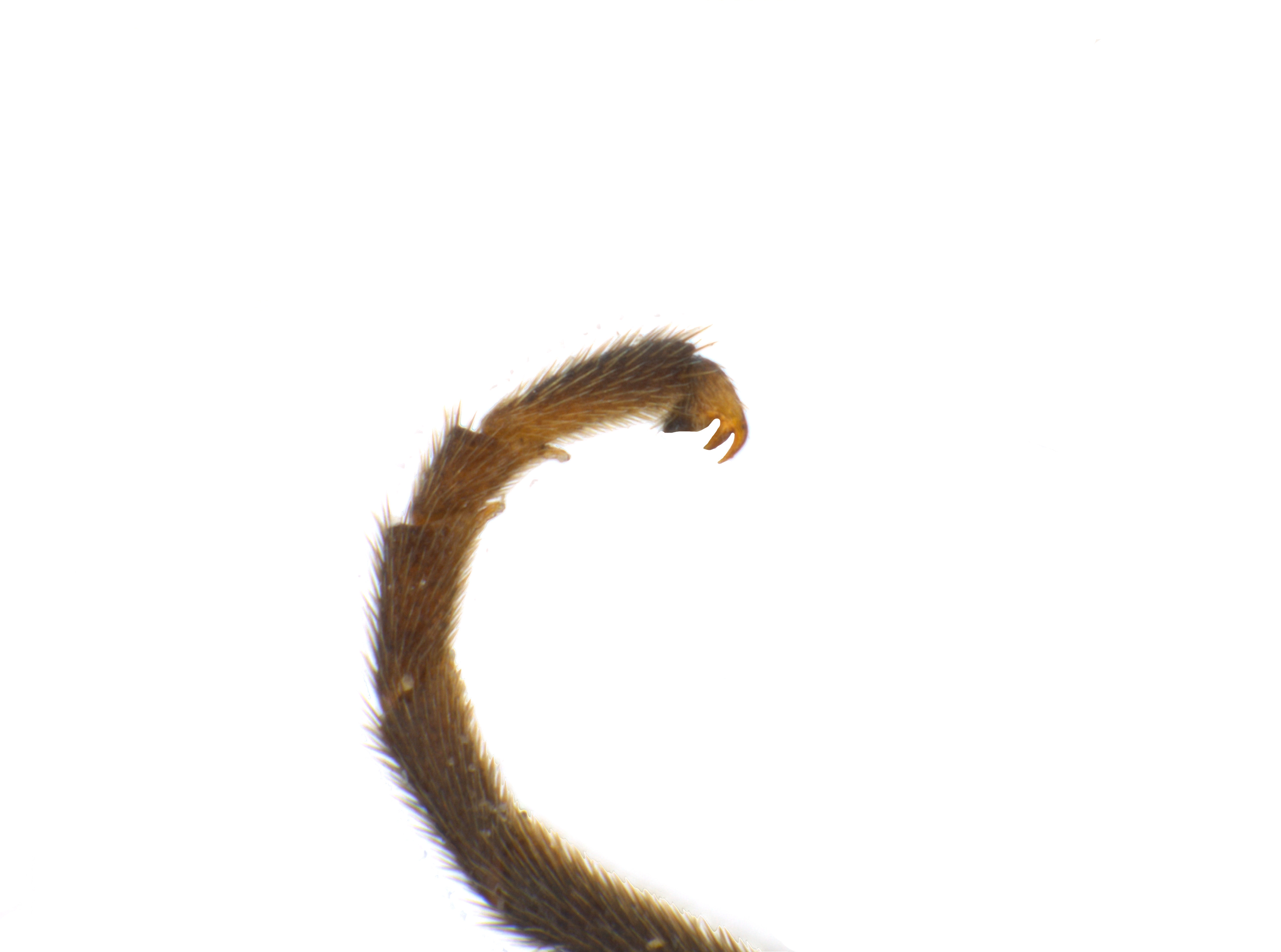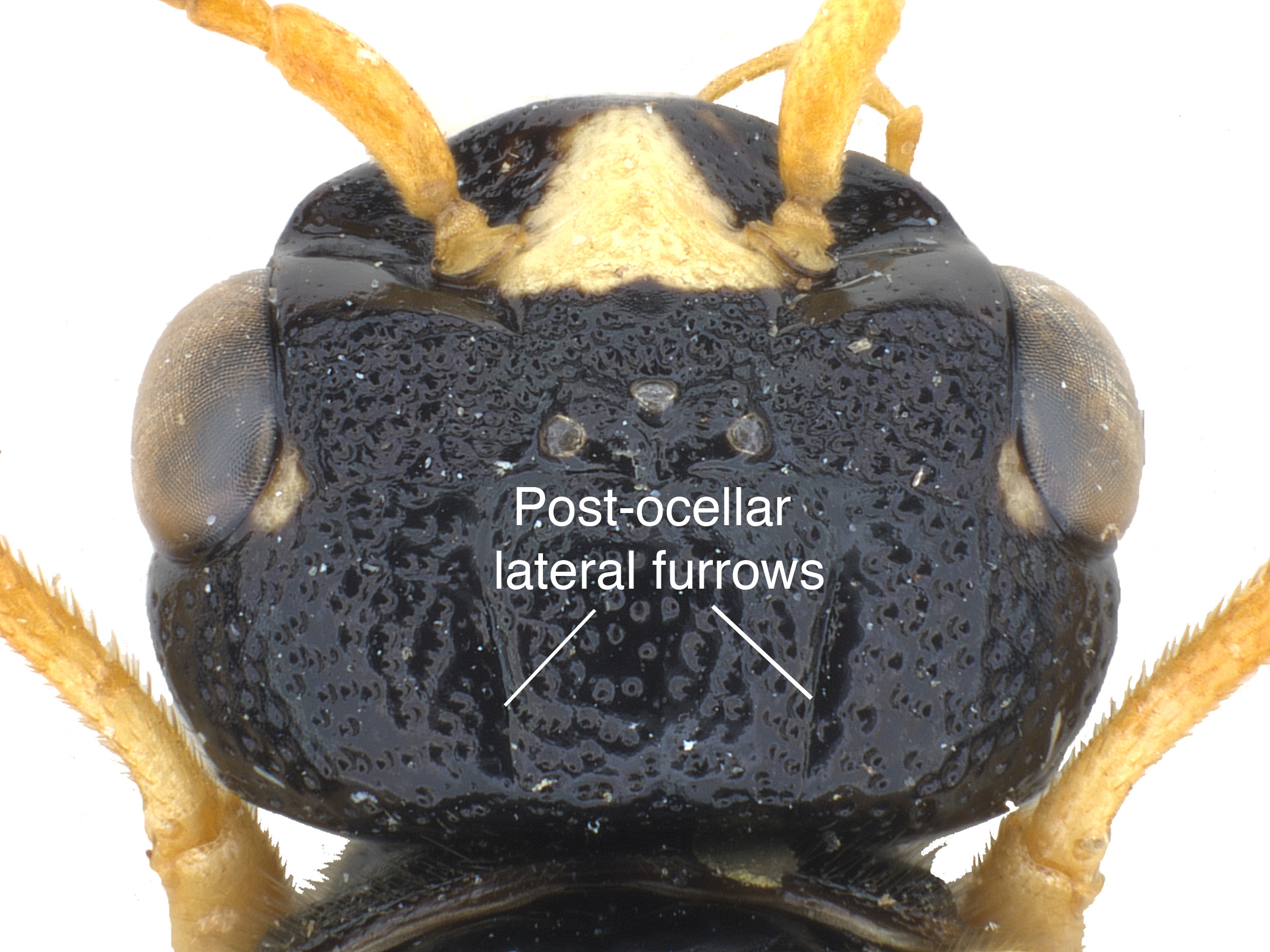Family: Tenthredinidae
Family common name: common sawflies
Subfamily: Blennocampinae
Tribe: Blennocampini
Genus: Periclista Konow, 1886
Subgenera: Periclista, Neocharactus
The Tenthredinidae are the most species-rich family and are found throughout the world, in all continents but Antarctica. They are known as the “common sawflies.” They can generally be recognized by a cylindrical body and long, segmented antennaeantenna:
the sensory organ emerging from the front of the head, usually between the compound eyes and above the clypeus; includes the flagellum, scape and pedicel
 . Otherwise, they come in a variety of colors, sizes, and forms (Goulet 1992Goulet 1992:
. Otherwise, they come in a variety of colors, sizes, and forms (Goulet 1992Goulet 1992:
Goulet H. 1992. The genera and subgenera of the sawflies of Canada and Alaska: Hymenoptera. Symphyta. The insects and arachnids of Canada. Part 20. Agriculture Canada Publication.).
Sawflies in the subfamily Blennocampinae have a diverse set of life histories and habits. Many species are restricted to subtropical and tropical regions, but the genus is still fairly species-rich in North America. Blennocampinae includes many sawflies that feed on ornamental and forestry crops. This subfamily can be recognized by wing venationvenation:
the network of veins on a wing
and bidentatebidentate:
having two teeth; often used in descrbing mandibles or tarsal claws
 mandibles (Smith 1969dSmith 1969d:
mandibles (Smith 1969dSmith 1969d:
Smith DR. 1969d. Nearctic Sawflies. I. Blennocampinae: Adults and larvae (Hymenoptera: Tenthredinidae). Technical Bulletin, U.S. Department of Agriculture 1397: 1-176.).
Periclista is fairly species-rich in the subfamily Blennocampinae. Periclista species are diverse, with a wide distribution. The majority of species are associated with oak trees (Stannard 1949Stannard 1949:
Stannard LJ. 1949. The Nearctic species of the genus Periclista (Hymenoptera: Tenthredinidae). Transactions of the American Entomological Society 75: 7-42.).
There are 65 described extantextant:
in existence; opposite of extinct
species worldwide. Twenty-six species occur in North America (Taeger et al. 2018Taeger et al. 2018:
Taeger A, Liston AD, Prous M, Groll EK, Gehroldt T, and Blank SM. 2018. ECatSymmdash;Electronic World Catalog of Symphyta (Insecta, Hymenoptera). Program version 5.0 (19 Dec 2018), data version 40 (23 Sep 2018). Senckenberg Deutsches Entomologisches Institut (SDEI), Muuml;ncheberg. https://sdei.de/ecatsym/ Accessed: 28 Jan 2020.).
Incomplete keys to species are included in Stannard 1949 (18 species of both subgenera) and Smith 2011Smith 2011:
Smith DR. 2011. The Nearctic oak-feeding sawflies of Periclista subgenus Neocharactus (Hymenoptera: Tenthredinidae). Transactions of the American Entomological Society 137 (3-4): 225-250. (Neocharactus species only).
Subfamily characters
 veins Cu1 and 1m-cu between 120°–150° (Goulet 1992Goulet 1992:
veins Cu1 and 1m-cu between 120°–150° (Goulet 1992Goulet 1992: veins M and 1m-cu parallel (Smith 1969dSmith 1969d:
veins M and 1m-cu parallel (Smith 1969dSmith 1969d: veins 2A and 3A incomplete (Smith 1969dSmith 1969d:
veins 2A and 3A incomplete (Smith 1969dSmith 1969d:Genus characters
 about as wide as long (Smith 1969dSmith 1969d:
about as wide as long (Smith 1969dSmith 1969d: present but indistinct, narrow, shallow, and without pits (Smith 1969dSmith 1969d:
present but indistinct, narrow, shallow, and without pits (Smith 1969dSmith 1969d: present, sometimes small (Goulet 1992Goulet 1992:
present, sometimes small (Goulet 1992Goulet 1992: veins 2A and 3A curved at apexapex:
veins 2A and 3A curved at apexapex: peripheral veinvein:
peripheral veinvein: present in subgenus Periclista (Goulet 1992Goulet 1992:
present in subgenus Periclista (Goulet 1992Goulet 1992: inner tooth long (Goulet 1992Goulet 1992:
inner tooth long (Goulet 1992Goulet 1992:Periclista can be confused with similar species in the subfamily Blennocampinae. It can be distinguished from most other genera by the long inner tarsal clawtarsal claw:
sharpened appendage emerging from the apex of the tarsus
 tooth and membranous area on the anepimeronanepimeron:
tooth and membranous area on the anepimeronanepimeron:
the dorsal protion of the mesepimeron
 . The male peripheral veinvein:
. The male peripheral veinvein:
a tube-like, often darkened, structure on the wings
 will easily distinguish the subgenus Periclista (Smith 1969dSmith 1969d:
will easily distinguish the subgenus Periclista (Smith 1969dSmith 1969d:
Smith DR. 1969d. Nearctic Sawflies. I. Blennocampinae: Adults and larvae (Hymenoptera: Tenthredinidae). Technical Bulletin, U.S. Department of Agriculture 1397: 1-176.).
Periclista albipennis is a pest of Quercus suber (cork oak) in Portugal, where larvaelarva:
the immature stage of holometabolous insects
 occur in high numbers and feed heavily on the foliage (Azevedo 1962Azevedo 1962:
occur in high numbers and feed heavily on the foliage (Azevedo 1962Azevedo 1962:
Azevedo ES. 1962. Note on Periclista albipennis Zadd. (Hymenoptera, Tenthredinidae), a pest of cork oak ( Quercus suber L.) in Portugal. Transactions of the 11th International Congress of Entomology 2 (7-14): 192-194.). Periclista andrei is a pest of Quercus ilex (holly oak) in Spain (Toimil 1987Toimil 1987:
Toimil FJ. 1987. Some insect defoliators of green oak ( Q. ilex L.) in the Huelva province. Boletiacute;n de Sanidad Vegetal, Plagas 13 (2): 173-188.). Severe damage to Quercus infectoria (Aleppo oak) has been inflicted by an unidentified Periclista in Iran, in some cases resulting in complete defoliation (Tavakoli et al. 2017Tavakoli et al. 2017:
Tavakoli M, Hosseini-Chegeni A, and Khaghaninia S. 2017. The first report of outbreak and identification of the larvae of oak defoliator wasp, Periclista sp. (Hymenoptera: Tenthredinidae) using COI gene from Iran. Iranian Journal of Forest and Range Protection Research 15 (2): 203-208.).
In North America, Periclista feeds on Quercus (oak) species including Quercus ilicifolia (bear oak), Quercus rubra (northern red oak), Quercus macrocarpa (bur oak), Quercus coccinea (scarlet oak), Quercus alba (white oak), Quercus montana (chestnut oak), Quercus wislizeni (interior live oak), and Quercus agrifolia (coast live oak) (Stannard 1949Stannard 1949:
Stannard LJ. 1949. The Nearctic species of the genus Periclista (Hymenoptera: Tenthredinidae). Transactions of the American Entomological Society 75: 7-42., Smith 1969dSmith 1969d:
Smith DR. 1969d. Nearctic Sawflies. I. Blennocampinae: Adults and larvae (Hymenoptera: Tenthredinidae). Technical Bulletin, U.S. Department of Agriculture 1397: 1-176., Smith 2011Smith 2011:
Smith DR. 2011. The Nearctic oak-feeding sawflies of Periclista subgenus Neocharactus (Hymenoptera: Tenthredinidae). Transactions of the American Entomological Society 137 (3-4): 225-250.). One species, P. marginicollis, feeds on Carya (pecan) (Stannard 1949Stannard 1949:
Stannard LJ. 1949. The Nearctic species of the genus Periclista (Hymenoptera: Tenthredinidae). Transactions of the American Entomological Society 75: 7-42., Goulet 1992Goulet 1992:
Goulet H. 1992. The genera and subgenera of the sawflies of Canada and Alaska: Hymenoptera. Symphyta. The insects and arachnids of Canada. Part 20. Agriculture Canada Publication.).
Adults of some species occur in high abundance where hosts are common. Females oviposit into fairly mature leaf buds. LarvaeLarva:
the immature stage of holometabolous insects
 feed externally on the leaves of the host plant. LarvaeLarva:
feed externally on the leaves of the host plant. LarvaeLarva:
the immature stage of holometabolous insects
 in most instars are light yellow-green and covered in many black-tipped spines. At maturity, larvaelarva:
in most instars are light yellow-green and covered in many black-tipped spines. At maturity, larvaelarva:
the immature stage of holometabolous insects
 fall to the ground, burrow into the soil, and overwinter in soil cells. Studied species are univoltineunivoltine:
fall to the ground, burrow into the soil, and overwinter in soil cells. Studied species are univoltineunivoltine:
describing an insect with a life cycle of one generation per year
(Beer 1955Beer 1955:
Beer RE. 1955. Biological studies in the genus Periclista (Hymenoptera, Tenthredinidae, Blennocompinae). Journal of the Kansas Entomological Society 28 (1): 19-26.).
World: This genus is known from North America, South America in Argentina and Chile, throughout Europe, and in North Africa, western Asia, Taiwan, China, and Japan (Smith 1984Smith 1984:
Smith DR. 1984. The sawfly genus Periclista in Korea and Taiwan (Hymenoptera: Tenthredinidae). The Korean Journal of Entomology 14(1): 1-8., Smith et al. 2002Smith et al. 2002:
Smith DR, Dapoto G, and Giganti H. 2002. A new species of Periclista (Hymenoptera: Tenthredinidae) associated with Nothofagus (Fagaceae) in Argentina and Chile. Entomological News 113 (5): 328-331., Taeger et al. 2018Taeger et al. 2018:
Taeger A, Liston AD, Prous M, Groll EK, Gehroldt T, and Blank SM. 2018. ECatSymmdash;Electronic World Catalog of Symphyta (Insecta, Hymenoptera). Program version 5.0 (19 Dec 2018), data version 40 (23 Sep 2018). Senckenberg Deutsches Entomologisches Institut (SDEI), Muuml;ncheberg. https://sdei.de/ecatsym/ Accessed: 28 Jan 2020.).
North America: Periclista occurs throughout the continental United States and in southern Canada (Smith 1969dSmith 1969d:
Smith DR. 1969d. Nearctic Sawflies. I. Blennocampinae: Adults and larvae (Hymenoptera: Tenthredinidae). Technical Bulletin, U.S. Department of Agriculture 1397: 1-176.).
Map data from: GBIF.org (29 October 2019) GBIF Occurrence Download Periclista
Details about data used for maps can be found here.